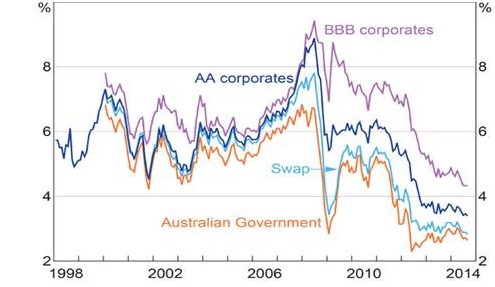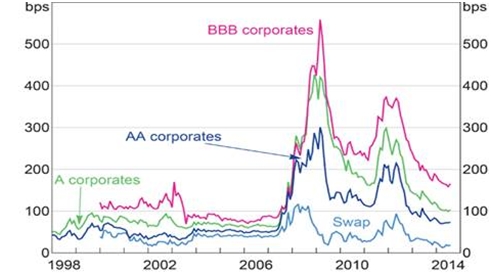by
Alen Golubovic | Sep 16, 2014
What is a credit spread?
The credit spread represents the difference in yield an investor receives for holding a corporate bond over a benchmark with comparable maturity, usually government securities or the swap rate, and is usually expressed in terms of ‘basis points’ over a particular benchmark. The spread measures the perceived riskiness, as deemed by the market, of a security against the reference interest rate curve. Credit spreads contract as the credit quality of the bond is perceived to improve, and vice versa - a logical extension of this concept is that the weaker the credit rating of a particular bond, the higher its credit spread should be relative to a more highly rated (or less risky) bond.
When comparing the relative value of two bonds using their credit spreads as a comparison, it is important that the same reference benchmark be used to allow a ‘like for like’ comparison. For example, if the credit spread for particular bond is against the government bond yield, it would be erroneous to compare this to the credit spread of another bond, where that particular spread is expressed over the swap rate.
Historical bond yields and credit spreads in Australia
Recently, the Reserve Bank of Australia (RBA) produced two charts outlining the historical trends of both corporate bond yields and credit spreads on Australian corporate bonds for different credit rating bands.
The first chart below shows the history of corporate bonds yields in Australia across various credit ratings versus the comparable swap rate and Australian Government bond yield. As expected, the Australian Government bond yield, being perceived to be the ‘risk free’ rate, has always historically represented the lowest yield instrument.

Source: RBA
The chart above demonstrates that government and corporate bond yields in Australia are currently at record lows compared to the last 25 years of history. In fact, when we compare current Australian government bond yields to the last 150 years of historical government bond yields, we find that yields have only been lower than current levels approximately 10% of the time. The current low yields are reflective of the current very low cash rate set by the RBA and what has been a relatively benign state of affairs in global capital markets following the Eurozone crisis in 2012. In saying this, the recent spate of geopolitical tensions has seen moderate increases in government bond yields over September.
The second chart shows the history of bond credit spreads over the comparable Australian Government bond yield for the categories of bonds as reflected in the first chart.

Source: RBA
There are three observations we can make from the chart above. Most relevantly, whilst past historical spreads shouldn’t be used as a predictor of where future spreads go, what we can see from the above chart of credit spreads is that, whilst Australian bond yields are at very low levels compared to historical levels, the credit spreads for Australian corporate bonds are currently roughly double the levels of where they were at prior to the GFC. The bond market is still pricing for credit risk at levels well above ‘pre-GFC’, despite overall record low bond yields.
We can also see that, in times of severe market distress, such as the GFC and subsequently the Eurozone crisis, there have been large spikes in the levels of credit spread, followed by large corrections in credit spread levels.
Finally, this chart shows clearly the relationship between perceived credit risk and the level of credit spread – for example, bonds which fall into the ‘BBB corporates’ category show the highest spread relative to ‘A corporates’ and ‘AA corporates’.
Copyright The contents of this document are copyright. Other than under the Copyright Act 1968 (Cth), no part of it may be reproduced or distributed to a third party without FIIG’s prior written permission other than to the recipient’s accountants, tax advisors and lawyers for the purpose of the recipient obtaining advice prior to making any investment decision. FIIG asserts all of its intellectual property rights in relation to this document and reserves its rights to prosecute for breaches of those rights.
Disclaimer Certain statements contained in the information may be statements of future expectations and other forward-looking statements. These statements involve subjective judgement and analysis and may be based on third party sources and are subject to significant known and unknown uncertainties, risks and contingencies outside the control of the company which may cause actual results to vary materially from those expressed or implied by these forward looking statements. Forward-looking statements contained in the information regarding past trends or activities should not be taken as a representation that such trends or activities will continue in the future. You should not place undue reliance on forward-looking statements, which speak only as of the date of this report. Opinions expressed are present opinions only and are subject to change without further notice.
No representation or warranty is given as to the accuracy or completeness of the information contained herein. There is no obligation to update, modify or amend the information or to otherwise notify the recipient if information, opinion, projection, forward-looking statement, forecast or estimate set forth herein, changes or subsequently becomes inaccurate.
FIIG shall not have any liability, contingent or otherwise, to any user of the information or to third parties, or any responsibility whatsoever, for the correctness, quality, accuracy, timeliness, pricing, reliability, performance or completeness of the information. In no event will FIIG be liable for any special, indirect, incidental or consequential damages which may be incurred or experienced on account of the user using information even if it has been advised of the possibility of such damages.
FIIG provides general financial product advice only. As a result, this document, and any information or advice, has been provided by FIIG without taking account of your objectives, financial situation and needs. Because of this, you should, before acting on any advice from FIIG, consider the appropriateness of the advice, having regard to your objectives, financial situation and needs. If this document, or any advice, relates to the acquisition, or possible acquisition, of a particular financial product, you should obtain a product disclosure statement relating to the product and consider the statement before making any decision about whether to acquire the product. Neither FIIG, nor any of its directors, authorised representatives, employees, or agents, makes any representation or warranty as to the reliability, accuracy, or completeness, of this document or any advice. Nor do they accept any liability or responsibility arising in any way (including negligence) for errors in, or omissions from, this document or advice. Any reference to credit ratings of companies, entities or financial products must only be relied upon by a ‘wholesale client’ as that term is defined in section 761G of the Corporations Act 2001 (Cth). FIIG strongly recommends that you seek independent accounting, financial, taxation, and legal advice, tailored to your specific objectives, financial situation or needs, prior to making any investment decision. FIIG does not make a market in the securities or products that may be referred to in this document. A copy of FIIG’s current Financial Services Guide is available at www.fiig.com.au/fsg.
An investment in notes or corporate bonds should not be compared to a bank deposit. Notes and corporate bonds have a greater risk of loss of some or all of an investor’s capital when compared to bank deposits. Past performance of any product described on any communication from FIIG is not a reliable indication of future performance. Forecasts contained in this document are predictive in character and based on assumptions such as a 2.5% p.a. assumed rate of inflation, foreign exchange rates or forward interest rate curves generally available at the time and no reliance should be placed on the accuracy of any forecast information. The actual results may differ substantially from the forecasts and are subject to change without further notice. FIIG is not licensed to provide foreign exchange hedging or deal in foreign exchange contracts services. The information in this document is strictly confidential. If you are not the intended recipient of the information contained in this document, you may not disclose or use the information in any way. No liability is accepted for any unauthorised use of the information contained in this document. FIIG is the owner of the copyright material in this document unless otherwise specified.
The FIIG research analyst certifies that any views expressed in this document accurately reflect their views about the companies and financial products referred to in this document and that their remuneration is not directly or indirectly related to the views of the research analyst. This document is not available for distribution outside Australia and New Zealand and may not be passed on to any third party without the prior written consent of FIIG. FIIG, its directors and employees and related parties may have an interest in the company and any securities issued by the company and earn fees or revenue in relation to dealing in those securities.